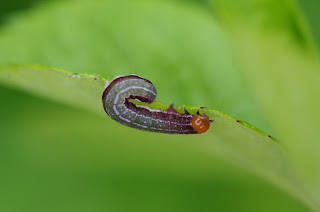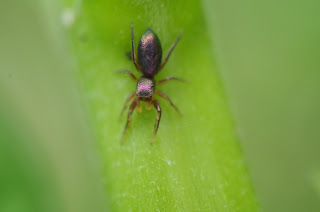Ooooooh dear. You know how I am always saying on this blog that you can't trust the internet? That any information you find on the internet is suspect? That any idiot (like me) could be in charge of a website, and present information that they really don't know anything about, and if they have a nice looking website, you might think that means that they know what they are talking about, but you shouldn't assume that? Well... don't trust the internet. The internet is often wrong. I have been trying to find an identification for today's Backyard Bug of the Day, which is a caterpillar. There is NO good source on the internet for caterpillar identification, I can tell you that right now. And frankly, none of the books I have at my disposal are all that good, either, including two caterpillar books that I have in my possession that belong to a friend. For some reason I really want to find out what kind of caterpillar this is, even though I normally don't go to this kind of effort, so I have been looking at a lot of sites that claim to be sources of that kind of information. In reality most of the sites have pictures of about 20 caterpillars, which is so far from being comprehensive that I wonder why they even bother. One of these sites gave a little blurb of information about each caterpillar, and under the picture of the saddleback caterpillar it said that the saddleback caterpillar is actually a slug, which is a mollusk. No. No. No. No. No. No. NO. NO. NOOOOOOOOOOOOOOOOOOOO. The saddleback caterpillar is a caterpillar. It is the larva of a moth, specifically the Acharia stimulea moth (I just looked that up on the internet, so don't be too sure about it). It is an insect of the order Lepidoptera. It is from a family of caterpillars that are called slug-like caterpillars because of the way they move - like slugs (But not even exactly like slugs, I don't think. I think there is a different mechanism to the way they do that. But don't trust me on that). They don't glide along on a layer of slime like slugs do. They don't have the same kind of prolegs that other caterpillars do. If you want to see how they move, you can check out THIS VIDEO that I posted a couple of years ago. But saddleback caterpillars are not actually slugs. They are INSECTS. They are ARTHROPODS. They are NOT MOLLUSKS. They are not closely related to mollusks. They have nothing in common with mollusks other than not having a spinal cord. And reading that extremely WRONG fact on that website just about made my head explode. So don't trust the internet. Except for two things - you can trust me when I say not to trust the internet. And you can trust me when I say that saddleback caterpillars ARE NOT MOLLUSKS.
Sigh. I also found a few other caterpillars that were misidentified. How am I supposed to learn anything if the information is either not there or incorrect? How am I supposed to trust the identification of the other 19 caterpillars on a site if I know for a fact that one of them is wrong?
By the way, I misidentified some forest tent moth caterpillars in recent posts as eastern tent moth caterpillars, so I have gone back and fixed them. You may have noticed that a lot of times when I identify things I say I think this is such-and-such, because I don't know for sure. And there is a disclaimer right in the intro to this blog that says not to trust any of my identifications. This is why. I don't know what I am talking about a lot of the time.
Backyard Bug of the Day:
After all that, I am sorry to report that I have no idea what kind of caterpillar this is. I have looked in every bug book at my disposal, and done a lot of searching on the internet, and I still can't find it. It was small, about an inch long, so it is possible that this is an early instar and will look different later in its development, but I still can't believe that I can't find it anywhere. Obviously, it exists. I just don't know what it is.
Definitely a caterpillar - check out those 5 pairs of prolegs.
I discovered a theme to my insect observations in the backyard today - The Insect Life Cycle:
This is how it begins. (These are two hoverflies. The female is the one holding onto the leaf. Not as impressive as the two hoverflies I saw mating aerially the other day).
Beetles
Next: Eggs
I didn't find any female bugs laying eggs, but I did find two kinds of eggs today.
Then: Larvae or nymphs:
Beetle larvae
Sawfly larva. I wonder if this is a later development of the one I saw last week that looked like this but with white spikes.
Katydid nymph
In case you are wondering what the difference is between a nymph and a larva, larvae go through complete metamorphosis. They look nothing like the adult form of the insect, and they go into a pupal stage in which they completely change from the larva to the imago (adult). Nymphs kind of resemble the imago stage of the insect, and will molt several times but not go through the complete metamorphosis of pupation.
Caterpillars are, of course, among the most famous larvae (and are not mollusks, no matter what anyone tells you). This one was doing yoga again today. This might be a copper underwing moth caterpillar.
And this I think is the eastern tent caterpillar.
Not as blue as the forest tent caterpillar, and much hairier.
Hoverfly larva
Hoverfly larva and aphid nymph. This is a dangerous situation for the aphid nymph - some species of hoverfly larva eat aphids.
Some nymphs are looked after by their parents... and ants. Not aunts, they are not related.
Nymphs in different stages of development.
I suspect that the color of this one could mean it has just molted, or is just about to. But don't trust me on that, I am just guessing.
I think this one is in one of the in-between stages, still a nymph, but getting close to imago stage. I think this might be the same kind of bug that was on those flowers last week (Yes, I know, that was completely unhelpful information).
And now random adult bugs, because I am done with this theme:
Lady beetle
Weevil
Hopper
Moth
There is a group of moths called owlet moths. I have no idea if this is one of them, but the reason I brought it up is because I think that owlet moths should be ones like this that look like tiny owls when you look at them upside down. Sadly, that is not what owlet moths are, and from what I read about them, I can't even tell you what it is that makes an owlet moth an owlet moth (most of them are nocturnal, but not all). But this one looks like an owl.
Hopper
Beetle
Yesterday I found nine different species of spiders in my backyard. Today I found four that I didn't find yesterday, which makes for 13 different species of spiders over 2 days. Arachnid Appreciation:
.
.
.
.
.
.
.
.
.
.
.
.
I think I was wrong yesterday, this is the species of spider I found all those babies of on Mother's Day weekend.
Back on our theme of earlier, here's a spider with her egg sac.
How could anybody NOT love a purple metallic jumping spider? So elegant!
Another jumping spider
This one was neighbors with the yoga caterpillar (that is NOT what the caterpillar's real name is).






































No comments:
Post a Comment